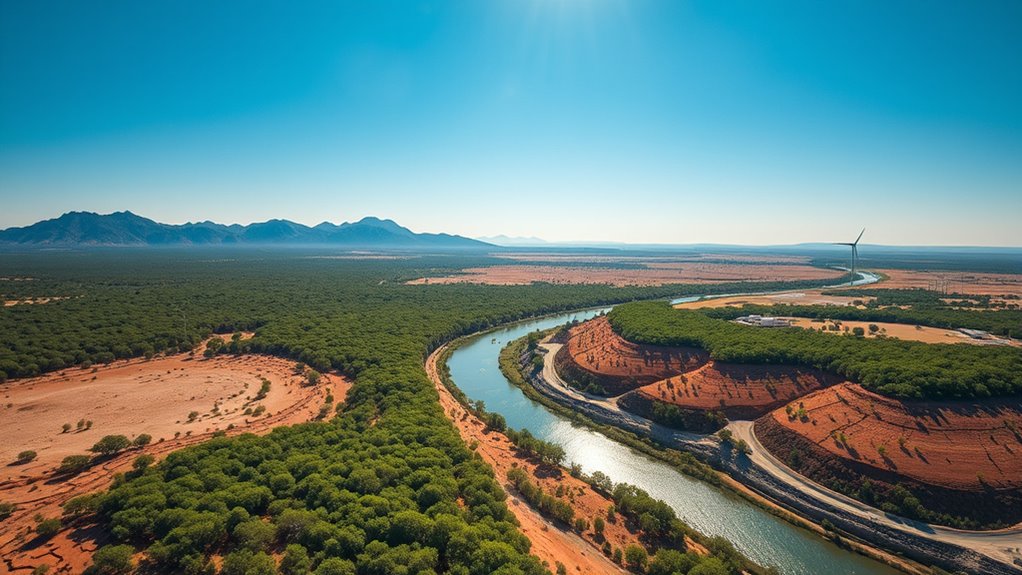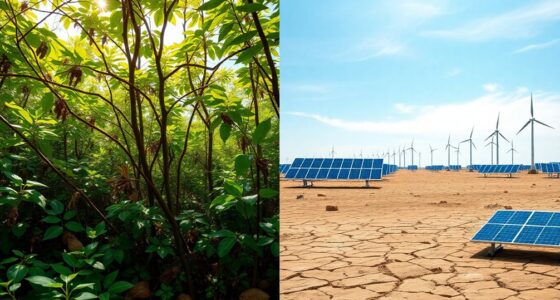To help combat global warming, you can support renewable energy sources like solar and wind, which reduce reliance on fossil fuels and lower emissions. You can also advocate for policies such as carbon pricing and invest in energy-efficient appliances to minimize your carbon footprint. Making small daily changes, like conserving water and reducing car travel, adds up. Embracing these strategies will guide you toward meaningful climate action—discover more ways to make a difference below.
Key Takeaways
- Transition to renewable energy sources like solar, wind, and hydro to reduce greenhouse gas emissions.
- Implement and support policies such as carbon pricing to incentivize emission reductions.
- Encourage daily sustainable choices, including energy efficiency, water conservation, and low-carbon transportation.
- Invest in renewable infrastructure and promote accessible, affordable clean energy solutions.
- Advocate for systemic policy changes and individual actions to foster a global movement toward climate conservation.

Have you ever wondered how your actions can help protect the planet? One powerful way is by supporting and utilizing renewable energy sources. Shifting to renewables like solar, wind, and hydro reduces our dependence on fossil fuels, which are major contributors to greenhouse gas emissions. When you choose renewable energy options—whether through your electricity provider or installing solar panels—you directly lower your carbon footprint. This change not only decreases the amount of carbon dioxide released into the atmosphere but also promotes a sustainable energy future. Governments and communities can accelerate this change by investing in renewable infrastructure, making clean energy more accessible and affordable. Your voice matters in advocating for policies that prioritize renewables, creating a ripple effect that benefits the entire planet.
Supporting renewable energy reduces emissions and promotes a sustainable future—your actions and voice make a global impact.
Another effective strategy is understanding and supporting carbon pricing initiatives. Carbon pricing assigns a cost to emitting carbon, encouraging businesses and individuals to reduce their emissions. When governments implement carbon taxes or cap-and-trade systems, they create economic incentives to cut back on activities that harm the climate. As a consumer, you can support companies that embrace carbon pricing policies, prompting more businesses to follow suit. This approach not only discourages pollution but also funds renewable energy projects and conservation efforts. By making pollution costly, society shifts towards cleaner technologies and more sustainable practices. Your support for policies that incorporate carbon pricing can drive systemic change, making it easier for everyone to contribute to climate conservation.
Beyond policy and infrastructure, your daily choices play an essential role. Using energy-efficient appliances, reducing car travel by biking or carpooling, and conserving water all contribute to lowering overall emissions. These small actions, when combined with larger systemic shifts, can have a significant impact. Public awareness campaigns and educational programs are indispensable in making these practices more widespread, empowering you and others to make informed decisions. Additionally, supporting organizations that focus on climate advocacy amplifies your voice and helps push for broader adoption of renewable energy and carbon pricing policies. Regular use of glycolic acid products can also promote healthier, more radiant skin, illustrating how small daily choices can extend beyond environmental impact to personal well-being.
Supporting renewable energy sources is crucial for a sustainable future, as it directly impacts the reduction of greenhouse gases. Moreover, increasing the adoption of energy-efficient appliances can significantly reduce household energy consumption and emissions. Ultimately, protecting the climate requires a multifaceted approach that involves governments, businesses, and individuals. By championing renewable energy, advocating for carbon pricing, and making sustainable choices in your everyday life, you become part of the solution. Each step counts in reducing the warming of our planet and ensuring a healthier, more resilient future. Your actions today can set a powerful example and foster a global movement toward meaningful climate conservation.
Frequently Asked Questions
How Does Climate Change Affect Global Biodiversity?
Climate change impacts your world by causing habitat loss and increasing species extinction. As temperatures rise, ecosystems struggle to adapt, leading to the loss of essential habitats for plants and animals. You may notice fewer wildlife sightings and declining biodiversity. This loss weakens ecosystems, reducing their resilience. By understanding these effects, you can support efforts to protect habitats, slow climate change, and preserve the rich diversity of life on Earth.
What Are the Economic Impacts of Climate Conservation Strategies?
You’ll find that climate conservation strategies impact the economy through cost-benefit analysis, which weighs the expenses against long-term gains. Implementing economic incentives encourages sustainable practices, boosting green industries and job creation. While initial costs may seem high, your investments can lead to reduced disaster recovery expenses and healthier ecosystems. Ultimately, these strategies promote economic resilience, ensuring that you benefit from a sustainable environment while supporting economic growth and stability.
How Can Individuals Effectively Contribute to Climate Preservation?
Think of your efforts like planting a single seed that grows into a forest. You can improve your personal habits—like reducing energy use, recycling, or walking instead of driving—and join community initiatives such as local clean-up events or tree planting drives. These small steps add up, creating a ripple effect that encourages others to act. Your actions inspire collective change, making a tangible difference in preserving our climate for future generations.
What Role Do Indigenous Communities Play in Climate Conservation?
Indigenous communities play a crucial role in climate conservation by leveraging their Traditional Knowledge and preserving Cultural Heritage. You can support their efforts by respecting their land rights and learning from their sustainable practices. Their centuries-old understanding of local ecosystems helps protect biodiversity and mitigate climate change. By amplifying their voices and collaborating with them, you contribute to more effective, culturally respectful conservation strategies that benefit both the environment and indigenous peoples.
Are There Innovative Technologies Advancing Climate Change Mitigation?
Did you know that over 80% of global emissions come from fossil fuels? You can explore innovative technologies like carbon capture, which traps CO2 emissions from power plants, and geoengineering solutions that reflect sunlight to cool the planet. These advancements are vital for mitigation efforts, offering promising ways to reduce greenhouse gases quickly. Embracing these technologies can help you contribute to a sustainable future and combat climate change effectively.
Conclusion
You now understand that taking action can make a real difference—yet, did you know global carbon emissions need to drop by 45% by 2030 to limit warming to 1.5°C? Every effort counts, from reducing energy use to supporting renewable sources. By staying informed and advocating for change, you help protect our planet’s future. Remember, individual choices ripple outward—your actions contribute to a healthier, more sustainable world for generations to come.









